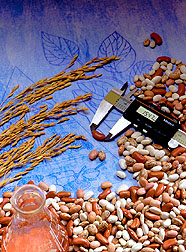This page has been archived and is being provided for reference purposes only. The page is no longer being updated, and therefore, links on the page may be invalid.
|
|
Better-Bean Information Available Online from NAL
By Len CareySeptember 6, 2006
The National Agricultural Library (NAL) has added the digitally reformatted annual reports and conference proceedings of the Bean Improvement Cooperative (BIC) to the information available online through the NAL Digital Repository. This addition includes significant information about the improvement of bean varieties, production and processing.
The library is part of the Agricultural Research Service, the U.S. Department of Agriculture's chief in-house scientific research agency.
The NAL Digital Repository (NALDR) provides convenient public access to the full text of selected publications which have been digitized. The repository is the initial component of what NAL plans as an integrated digital repository for agricultural literature incorporating an array of electronic documents.
Addition of the bean improvement information to the NALDR is one result of an 11-year collaboration between NAL and BIC.
Located in Beltsville, Md., NAL is the world's foremost agricultural library, housing one of the largest and most accessible collections of information about agriculture and its related sciences.
The BIC is a voluntary organization established to exchange information and materials for the improvement of bean production worldwide. The full set of BIC annual reports and conference proceedings added to the NALDR dates to Volume 1, published in 1957. Information contained in these reports is not readily available elsewhere.
Dry beans are an economical source of protein, fiber, iron and other essential nutrients, yet are low in total fat, so they can be an important component of a healthy diet. The 2005 Dietary Guidelines for Americans and the USDA MyPyramid Food Guidance System recommend that adults eat about three cups of beans or legumes each week. Having dozens of bean varieties available makes it easy for consumers to include tasty bean dishes for a healthier diet. U.S. consumer choices include red, pink, pinto, navy, white, cranberry, yellow-eyed, limas and black beans.

